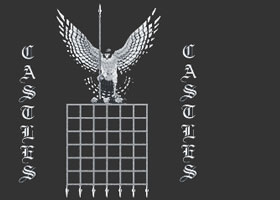Medieval Clothing - Design of Medieval Clothes
- Medieval Clothing fabrics used
- Medieval Clothing used by Nobles
- Medieval Clothing worn by Women
- Fabrics and status in Medieval times
- Clothing colours and status indicated
Medieval Clothing - The Fabrics
The type of cloth and fabric used for Medieval clothing was therefore extremely important. People of the Lower Classes wore clothing generally made of wool, linen and sheepskin. Medieval Nobles and Upper classes wore clothing made of velvets, furs, silks, lace, cottons and taffeta. Knights returning from the Crusades returned with silks and cottons from the Middle East. Velvets were imported from Italy. The materials worn by the Nobility came in a variety of different colors. The dyes used for coloring these clothes were expensive. The red dye came from a Mediterranean insect which provided a bright scarlet color. Green dyes came from lychen. the Dyerswoad plant provided dyes for the remaining blue-based colors. The Medieval Clothing of Peasants
The Medieval clothing of peasant men consisted of a Knee length tunic fastened with a belt. Others wore linen shirts or rough woollen shirts. Peasant men often went bare-legged or simply bound their legs with strips of linen. Peasant women wore a longer dress made of similar material which was also fastened with a belt. Medieval Clothing of Noblemen
The Medieval clothing of the Noblemen consisted of trousers covered with long over tunics called bliauds. Tabards and Surcoats were also worn. These clothes were covered with full length cloaks. The cloaks were trimmed with an expensive fur and pinned at the shoulder with a broach. They wore shoes designed for castle wear made of silk, velvet, cloth or leather and fastened with a buckle. The indoor shoes worn with Medieval clothing were covered with wooden and leather outdoor overshoes. Hats were also part of a nobles clothing which were similar to a cap and pointed at the front. The materials were made of velvets, silks, lace, cottons and taffeta and dyed in bright colors. In the 14th century Medieval clothing included underclothes consisting of breeches, chemise and hose. Additional information is available by clicking the following link - Medieval Knights Armor Medieval Clothing of Noble Women
The Medieval clothing of the Noble women consisted of many layers of clothes. They wore underclothes consisting of breeches, chemise and hose. The underclothes in Medieval Clothing were covered with an underskirt usually made of yellow or white linen or silk. The underskirt was covered with a long, trailing gown, or dress, with wide sleeves. The gowns were made of velvets, furs, silks, lace, cottons and taffeta. The hem and the neck of the gown (dress) and sleeves were often decorated with gems and lace. The gowns were covered with long over tunics called bliauds. Tabards and Surcoats were also worn over the gowns and dresses. These clothes were covered with full length mantel. The mantels were trimmed with an expensive fur and pinned at the shoulder with a broach. They wore shoes designed for castle wear made of silk, velvet, cloth or leather and fastened with a buckle. The indoor shoes were covered with wooden and leather outdoor overshoes. Women wore their hair long and plaited which was covered by a Wimple or a Guimpe - a piece of silk or linen draped and pinned over the hair, wrapped around the throat and tucked into the neckline of the gown. Hats were were later added as part of the clothing of a noble women which grew bigger as fashion dictated featuring tall points, some shaped as the horns of cows. The Medieval Clothing materials were made of velvets, silks, lace, cottons and taffeta and dyed in bright colors. For additional, comprehensive information regarding Medieval Clothing we highly recommend the following sites: Middle Ages Clothing Elizabethan Clothing |

